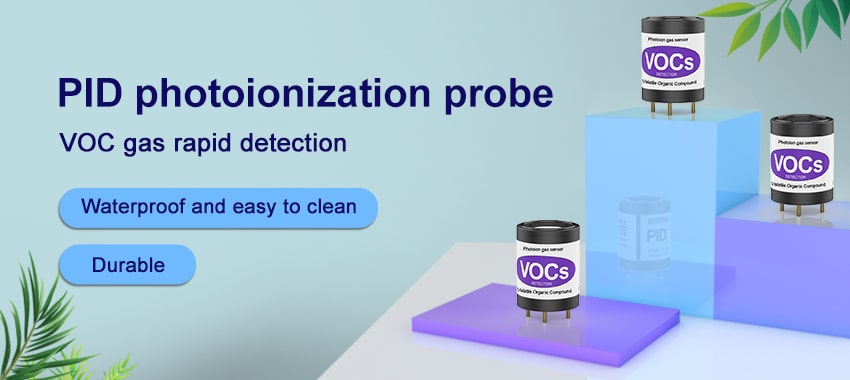Background:
At present, the oil at domestic gas stations is mainly gasoline, which is determined by the low boiling point of light oil such as gasoline (50~ 200E) and its physical characteristics such as volatility, and the generation of hydrocarbon VOCs at gas stations is inevitable. Therefore, it is necessary to install VOC online monitoring system, which can use PID sensor to collect and detect VOC.
Under normal circumstances, the normal operation of the gas station VOC mainly generated in loading and unloading and refueling operations of two links: in loading and unloading operations, the tank truck through the oil pipeline to the storage tank, the tank liquid level rises, forming a positive pressure, saturated oil vapor in the tank from the ventilation pipe to the atmosphere;
In the refueling operation, due to the non-close connection between the refueling gun and the tank mouth, a large number of oil and gas are discharged from the tank mouth into the atmosphere. In addition, in the storage of oil, due to the change of environmental temperature, the saturated oil and gas in the tank also exist breathing loss, but this part of the emission is relatively less.
VOC harms are divided into two aspects:
Harm to human body:
VOC gases have a huge impact on human health. Exposure to a certain concentration of VOC will damage the nervous system and destroy the hematopoietic function, and even lead to cancer and other serious diseases. When VOC in the room reaches a certain concentration, in a short period of time, people can feel headache, nausea, hair and other conditions, severe convulsions, coma and other conditions.
Harm to the environment:
VOC gas can also cause damage to the atmosphere. VOC is one of the important reasons for the increase of atmospheric ozone concentration and the formation of regional photochemical smog, acid rain, and smog complex pollution. VOC is the precursor of PM2.5 and ozone. VOC accounts for more than 25% of PM2.5 in the atmosphere. VOC will always cause the greenhouse effect, leading to global warming.
At present, photochemical pollution caused by volatile organic compounds (VOC) has become an important environmental problem faced by some cities in China. The evaporation of oil from urban gas stations is an important source of VOC emissions, and the chemical activity of VOC species contained in oil steam is very high, so the contribution rate of VOC emissions from gas stations to ozone generation cannot be ignored.
VOC online monitoring system introduction:
VOC online monitoring system for the presence of VOC gas in the air, wireless transmission technology, database technology, software technology and sensor detection technology combined, real-time monitoring of gas station emissions in the temperature, humidity, VOC concentration and other related parameters, through logical judgment and intelligent analysis, output VOC levels and alarm signals, So as to improve and enhance the ability of remote monitoring and early warning of atmospheric environment, timely remind and deal with environmental deterioration.
JXCT recommends a PID sensor that can detect VOC in the gas station VOC online monitoring system.

PID sensor principle introduction:
PID sensor is a photoionization detector, mainly used to detect volatile organic compounds and other toxic gases at low concentrations of 1ppb-15000ppm. PID is a highly sensitive and versatile detector.
The PID sensor uses an ULTRAVIOLET (UV) light source to ionize organic molecules into positive and negative ions (ionization) that can be detected by the detector. The detector picks up the positive and negative charges of the ionized gas and converts them into an electrical signal to measure the gas concentration.
When the gas to be measured absorbs high energy uv light, the gas molecules temporarily lose electrons and become positively charged ions under the excitation of UV light. The gas ions are detected at the detector’s electrode and soon combine with electrons to reform the original gas and vapor molecules. The PID sensor is a non-destructive detector that does not “burn” or permanently change the gas molecules under test. The gas detected by PID can still be collected for further determination.

What are the detection parameters?
In theory, all chemicals can be ionized, but they require different amounts of energy to be ionized. The energy that can transfer an electron and ionize a compound is called ionization energy and is measured in electron volts (eV). The energy emitted by uv lamps can also be measured in electron volts. If the ionization energy of a gas is lower than the energy emitted by the lamp, the gas will be ionized. The most important gases or volatiles that can be detected by PID are large quantities of organic compounds (VOCs) containing carbon atoms. including
Aromatic: compounds containing benzene rings, such as benzene, toluene, ethylbenzene, xylene, etc.
Ketones and aldehydes compounds containing C=O bonds. Such as: acetone, butanone, formaldehyde, acetaldehyde and so on;
Amines and amino compounds hydrocarbons containing N. Such as: diethylamine;
Halogenated hydrocarbons: such as trichloroethylene (TCE), perchloroethylene (PCE), etc.;
Sulfur-containing organic matter: methanethiol, sulfide, etc.
Unsaturated hydrocarbons: butadiene, isobutene, etc.
Saturated hydrocarbons: butane, octane, etc.;
Alcohols: isopropyl alcohol (IPA), ethanol, etc.